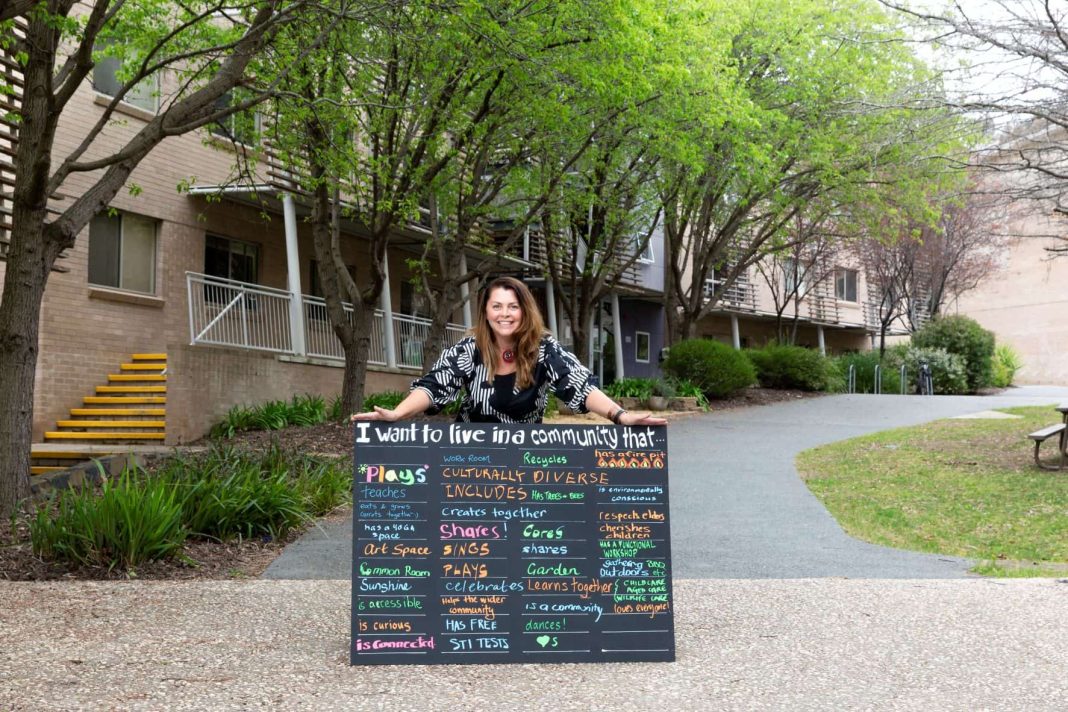“I don’t want to live in a far-flung suburb by myself in a house – I want to live a connected life,” says lifetime Canberra resident, 50-year-old Cris Clucas.
Deputy Principal of ANU’s Burgmann College, Cris is a single mum who was fortunate enough to purchase an affordable home in the very north of Canberra in Gungahlin.
While not under any illusion about the auspicous position she found herself in, the isolation that grew from living away from her support system sparked her advocacy for cohousing in Canberra.
“From my house I could see Black Mountain Tower in the distance, the very distance, and I’d think ‘oh, that’s where my friends are’, you know. It’s weird – they’re great friends but they only came to visit me twice the whole time that I lived there. It was easier for me to go to them,” Cris says.
“The suburb I lived in was an affordable suburb, there are lots of low socioeconomic people that live there; me, at the time – I’m a single parent – recent immigrants. We didn’t have time, because we were working our butts off to survive, to have the energy to reach out and connect in that way.
“I’ve talked about being isolated out there and people have been like ‘oh, it’s so easy to just go and talk to your neighbour’ and yeah, I did talk to my neighbour, but we were busy working and tired and I was pretty exhausted being a single parent and working fulltime, so I just found it a really isolating experience.”
Cris has now moved onto the Burgmann College campus for her job, which she says is a great example of a cohousing development.
‘I want to be surrounded by people’
What began in Denmark during the 1970s has trickled down through generations and countries to now land in Canberra, with community groups pushing to transform the way society builds housing.
“A cohousing development is like no other,” says Cris. “It’s a group of people who probably have shared values getting together, they find a block of land, and they’re involved in the process of what the development will look like.
“A cohousing development is made up of individually owned homes, just like a home you and I would own, with a kitchen, bathroom and all the usual amenities, but it’s on a shared block of land.”
Usually comprised of around 30 dwellings with a shared common house that features an industrial kitchen and living area, along with shared gardens, cohousing involves members coming together to govern their community and do activities together – whatever they might be. The layout resembles a village with footpaths connecting building to building.
“When people live a connected life, especially when we get older, it’s been shown that people live longer lives and they have less reliance on services. So that’s a really important aspect of this way of living,” says Cris.
“The great thing about cohousing is you do have your private space, it’s your home, you can do whatever you like as you would normally, but if you wanted to be around people, you can.”
A broken laptop and the Canberra Innovation Network
One driving factor of Cris’s passion for cohousing fell into her lap from pure chance – her broken laptop and a Canberra Innovation Network competition offering a cash prize.
“My laptop broke, and I saw the Canberra Innovation Network was having this competition, and so I thought I’ll just enter this competition. It was about an idea that could make Canberra a better place in 2040 and I love daydreaming about the future, so I thought ‘yeah, that’s cool, that’s right up my alley’ and so I decided to talk about cohousing,” says Cris.
Pulling together a three-minute pitch about her experience living in a new outer suburb, its disconnected and “jammed in” layout, and why she believes cohousing is the answer to loneliness, Cris ended up winning $5,000.
“My idea that I used in the competition was to have a cohousing development with an early childhood centre, and I could go and hang out there and it would be like that TV show,” Cris smiles.
“Having that connection would be amazing, I mean, I’m 50, and I feel like in 20 years’ time, which is not long, I won’t want to be by myself somewhere, I’d want to be surrounded by people.”
The competition flicked a switch for Cris and instead of using the prize money to fix her broken laptop, she organised a symposium to talk about cohousing and add her voice to the chorus of advocates at Cohousing Canberra.
She describes the event as a “massive success” although there wasn’t as much support shown from local politicians as she would have hoped.
“We had 70 people in the room and 40 online including a bunch of architects and maybe one adviser to a Greens MLA, which is cool. Not as many politicians as I was hoping for but what can you do,” says Cris.
“So, the feeling was amazing, actually. People were really excited about the possibility of getting co-housing happening in Canberra, so it felt good.”
Her hope for the future is to plant the seed for Canberrans and the government to recognise cohousing is an option, and we should be thinking about it.
“By 2040, Canberra’s going to need 100,000 new homes to house our population and I don’t want to see sardine suburbs out there. I think we need to consider something new,” says Cris.
Get all the latest Canberra news, sport, entertainment, lifestyle, competitions and more delivered straight to your inbox with the Canberra Daily Daily Newsletter. Sign up here.



